
Yellow flag iris is an invasive weed in Washington, it can sicken livestock and takeover wetlands.
If you live in Washington, chances are you’ve heard of toxic algae blooms, seen a shoreline covered with cattails, or maybe you’ve had Eurasian watermilfoil tangle your paddle or choke your boat motor. While we are fortunate to have some amazing waterbodies in this state, it can take a lot of work to maintain the health of rivers, streams, and lakes. For the most part, this means Ecology works to reduce the amount of chemicals going into the water. However, there are circumstances where certain chemicals can actually help achieve clean water and preserve the beneficial uses of water.
Managing aquatic plants and algae
This view of a toxic algae bloom in Big Lake is a scene known all too well to many of Washington's lakes.
For decades, we've been required by state law to provide a permitting program that allows lake managers to use pesticides and other chemicals to control noxious aquatic weeds. The permit applies to fresh water bodies and shorelines as well as roadside ditches. Our permitting program only allows registered pesticides that do not pose a risk to the environment or public health. These registered pesticides are approved by the U.S. Environmental Protection Agency and the Washington State Department of Agriculture. To make sure these pesticides meet state laws, we further review these chemicals through an environmental impact statement.
An excerpt from RCW 90.48.447 helps explain why Washington has a general permit for Aquatic Plant and Algae Management:
“The legislature finds that the environmental, recreational, and aesthetic values of many of the state’s lakes are threatened by the invasion of nuisance and noxious aquatic weeds. Once established, these nuisance and noxious aquatic weeds can colonize the shallow shorelines and other areas of lakes with dense surface vegetation mats that degrade water quality, pose a threat to swimmers, and restrict use of lakes. Algae can generate health and safety conditions dangerous to fish, wildlife, and humans.”
The general permit
Water quality permits are a legal tool to limit the discharge of pollution into the water. Each permit is different and sets specific methods for release, monitoring, and mitigating any potential environmental damage. A water quality general permit is a type of permit that regulates a number of different businesses — based on similar discharge characteristics — under one permit. If each applicant meets the requirements of the permit they are granted authorization to discharge. The permit holder must follow the conditions and requirements in the permit. Failure to do so can result in enforcement action by Ecology.
Each general permit is updated on a five year cycle, where we look at how the permit is working; incorporate feedback from permittees, tribes, and stakeholders; and review any new, relevant science.
We're currently working to update the Aquatic Plant and Algae Management general permit. Specifically, for this permit we also review monitoring data, modify timing windows or propose other actions that better protect sensitive species.
Eurasian milfoil is a well-known and very problematic noxious weed in Washington.
What’s in the permit?
The Aquatic Plant and Algae Management general permit requires people to use management solutions that have the least environmental impact among reasonably available options. Chemicals can sometimes be the least invasive solution to control plants and algae.
If a local authority — like an irrigation district, municipality, or HOA for a lake community, decides that as part of an integrated pest management approach registered pesticides or chemicals are needed to control a nuisance plant or algae — then they have to apply for coverage under Ecology’s permit. We do not provide permittees with consultation or advice on which approaches to use, we are only involved to make sure any chemical use is done safely and in accordance with the law under the permit. It is common to use a mix of approaches to get nuisance plants or algae under control. Non-chemical approaches can include mechanical weed harvesters, bottom barriers, and education and outreach programs such as the Clean, Drain and Dry program.
Our permit ensures the chemicals used, and the methods by which they’re applied, are the least harmful to animals and other plants. The permit limits which chemicals are allowed to be used, where they can be used, and who may use them. They also require public notification before a water body is treated, and outline specific rules around the reporting and timing of applying the chemical.
Signs for modern times
As part of this permit update, we are proposing a new style of sign to meet the permit requirement for treatment notification. These notification signs are required whenever pesticides are used and have a warning statement at the top, usually Caution, Warning, or Danger, to signify the warning level followed by specific text information.
Over the years, we’ve heard ideas on how to improve these signs to add graphics so they are not so text heavy. The new signs proposed in the new permit rely more on iconography or simple images to convey message. Providing signage that is easily understood by anyone, regardless of literacy level or primary language, is important for protecting public health. We welcome input on how to make further improvements to the signs. See how to comment below.
We are also clarifying how permittees need to label their intended treatment area on their public notices. This update is the result of feedback provided to us based on confusion in other pesticide treatment notices.
By using icons and better organizing the image, we hope the new notification templates result in more awareness and better public health protection.
Additional Updates
There are a number of updates proposed throughout the permit, most of which are clarifications and refinements. All proposed changes can be found in the draft factsheet. Here are a few of the updates:
- Changed “Phosphorous Inactivation” to “Phosphorous Sequestration” throughout the permit
- Added additional algae treatment dissolved oxygen monitoring/application restrictions
- Experimental use section reflects tighter restrictions and we’ve added an application template
- The section on treatment timing windows has a number of revisions, including a new process for permitees to request modified pesticide application timing windows
- Permittees are now directed to the WDFW map, and the approved active ingredients table in the permit labels the seven chemicals that have fish restrictions. The new WDFW timing window map tool is available online.
We invite your comments
We are seeking comments from Oct. 21, 2020 until Dec. 7, 2020, 11:59 p.m. Also, we are hosting two online public workshops and hearings on the draft permit. At the workshop, we will give a presentation to help explain the draft permit and answer questions. Following the workshop, the hearing will provide the opportunity for the public to provide formal oral testimony and submit written comments on the draft permit. Oral testimony will receive the same consideration as written comments. The public hearing will begin immediately following each workshop and will conclude when testimony is complete.
How to provide comments
You may submit comments:
- Online: Submit your comments through our online comments form (preferred method)
- By mail:
Danielle Edelman
Washington State Department of Ecology
PO Box 47696
Olympia, WA 98504-7696 - In person virtually: You may provide verbal comments during any of our public hearings
The workshops and hearings will be held:
Online workshop: Dec. 2, 2020 10:00 a.m.
Join the webinar
Online workshop: Dec. 3, 2020 5:30 p.m.
Join the webinar
The workshops and hearings offered via webinar allow individuals to view the presentation and provide testimony by computer, phone, or other mobile device.
Additional information on how to comment is available on the permit webpage.
Next steps
After we review the feedback we receive on the draft permit and related materials, we will make the appropriate revisions, prepare a response to public comments, and make a decision on final permit reissuance. We expect to have a decision by March 2021.




